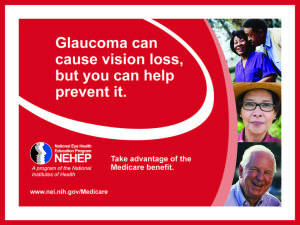Glaucoma is a group of eye diseases in which the pressure inside the eye may or may not be elevated. If untreated, vision loss or blindness may occur.
January is Glaucoma Awareness Month
Unfortunately, the most common type of glaucoma – open angle, causes no symptoms. Vision doesn’t change, and there is no pain. However, as the disease progresses, a person with glaucoma may notice his or her side vision gradually failing. That is, objects in front may still be seen clearly, but objects to the side may be missed. As the disease worsens, the field of vision narrows and blindness results.
Studies have shown that early detection and treatment of glaucoma, before it causes major vision loss, is the best way to control the disease. So, if you fall into one of the high-risk groups for the disease, make sure to have your eyes examined annually. Individuals at high risk for glaucoma include African Americans over the age of 40, everyone over 60 and people with a family history of glaucoma.
There isn’t a single test to diagnose glaucoma. Drs. Griffith and Staton examine the appearance of the optic nerve, the intra-ocular pressure and visual field results. Further testing such as measurement of the corneal thickness (pachymetry), examination of the anterior chamber and measurement of the integrity of the nerve fiber layer can be helpful in the diagnosis and treatment of glaucoma.
